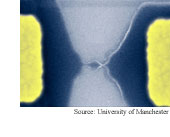|
NEWS
|
Carbon chips
 A transistor made from a strip of carbon one atom
thick and less than 50 atoms wide shows that graphene
-- single-atom sheets of carbon -- could replace silicon
computer chips when silicon chips can no longer be made
smaller in a decade or two. Previous graphene transistors
made from wider carbon sheets were inefficient. (The
Rise of Graphene, Nature Materials, March 2007)
A transistor made from a strip of carbon one atom
thick and less than 50 atoms wide shows that graphene
-- single-atom sheets of carbon -- could replace silicon
computer chips when silicon chips can no longer be made
smaller in a decade or two. Previous graphene transistors
made from wider carbon sheets were inefficient. (The
Rise of Graphene, Nature Materials, March 2007)
Tight microwaves
Bouncing a signal back to the transmitter makes
it possible to focus microwaves to as small as one-thirtieth
of a wavelength. The technique could be used to speed
microwave-based telecommunications; in one experiment
the information transmission rate increased three-fold.
(Focusing
Beyond the Diffraction Limit with Far-Field Time Reversal,
Science, February 23, 2007)
Bone printer
Forming artificial bone layer by layer using an
inkjet printer can be gentle enough to incorporate biological
molecules that encourage the growth of blood vessels.
The technique could make it possible to form bone grafts
that readily meld into living bone. (Direct
Printing of Bioceramic Implants with Spatially Localized
Angiogenic Factors, Advanced Materials, Published
online February 27, 2007)
Artificial ligaments
Braided polymer strands seeded with ligament cells
successfully replaced ruptured anterior cruciate ligaments
(ACL) in laboratory rabbits. The rabbits could put weight
on their surgically-repaired knees within 24 hours and
new blood vessels and collagen were found in the affected
area at the end of the 12-week study. (Biomimetic
Tissue-Engineered Anterior Cruciate Ligament Replacement,
Proceedings of the National Academy of Sciences,
February 27, 2007)
Tiny devices get pumped
Tiny diodes floating in water can propel themselves
in the presence of an alternating electric field. The
technique could be used to power micromachines and to
pump and mix fluids in biochips. (Remotely
Powered Self-Propelling Particles and Micropumps Based
on Miniature Diodes, Nature Materials, March
2007)
Phosphorescence goes red
A bright red phosphorescent resin rounds out the
full-color spectrum of phosphorescent materials, which
produce light for a limited time without a power source.
Full-color phosphorescent materials could be used to make
signs for guiding people in disasters. (Full-color
Illumination That Needs No Electric Power, Optics
Express, February 19, 2007) |
FEATURES
|
View
from the High Ground: ICL's John Pendry
Physics as machine tool, negative refractive
index, metamaterials, shattered wine glasses, higher capacity
DVDs, scientific backwaters, risk perception and practice,
practice, practice.
|
How
It Works: Quantum computing: qubits
Photons, electrons and atoms, oh my! These particles are
the raw materials for qubits, the basic building blocks
of quantum computers. |
|
 |
News RSS feed 
Blog RSS feed 
Bookshelf RSS feed

New: TRN's
Internet Services
TRN's Jobs Center
|
| |
|
| |
|
| |
"Physics
is to the rest of science what machine tools are
to engineering. A corollary is that science places
power in our hands which can be used for good or
ill. Technology has been abused in this way throughout
the ages from gunpowder to atomic bombs."
- John Pendry, Imperial College London |
|
| |
|
| |
Thanks
to Kevin from
GoldBamboo.com
for technical support |
|

